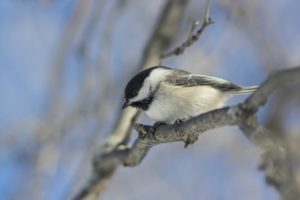Much Loved Visitor
Definitely one of the most researched of all backyard birds, the Black-capped chickadee is also one of the most loved backyard visitor. Comfortable in the presence of humans, delicate in the way they eat and most of all, cheerful even when the weather in winter is at its worst, they come by their connection with humans honourably. And no matter how harsh our winter we always have the delightful presence of this tiny creature. Often they are the first to arrive when you refill your feeder.
The collective noun for a group is a banditry of chickadees, perhaps because their markings make them look like they are wearing a mask. There are seven species of chickadees found around the world. Of the five found in North America, the black-capped is the most common and is found over the widest area. They are the provincial bird of New Brunswick. Adult Chickadees don’t migrate. In years when chickadee reproduction is high, young birds sometimes move large distances, but these movements are irregular and are more accurately called “irruptions.
Food Caching
The Black-capped chickadee hides seeds and other items to eat later. Each item is placed in a different spot and the Chickadee can remember thousands of hiding places. This phenomenon of caching is not unique to chickadees. Some food caching bird species can have over 10,000 caches. How do they remember where the food is? Research has shown the brains of chickadees in more northerly regions where winter weather is harsher, are different. Their hippocampus, the area of the brain instrument in spatial memory, is larger, and they do in fact demonstrate better spatial memory than their southern cousins. Interestingly, the Mexican chickadee is the only chickadee that does not cache food.
Every autumn a black-capped chickadee allows brain neurons containing old information to die, replacing them with new neurons so they can adapt to changes in their social flocks and environment even with their tiny brains.
Winter Flocking with Other Species
Winter flocks of Chickadees serving as the nucleus contain mated Chickadee pairs and non-breeders, but generally, not the offspring of the adult pairs within that flock. Other species that associate with Chickadee flocks include Nuthatches, Woodpeckers, Kinglets, Creepers and Vireos. The chickadee name comes from their alarm call. The more “dees” at the end of the call the greater the alarm. Most birds that associate with Chickadee flocks respond to Chickadee alarm calls, even when their own species doesn’t have a similar alarm call. Because small songbirds migrating through an unfamiliar area often associate with Chickadee flocks, watching and listening for Chickadee flocks during spring and fall can often alert birders to the presence of interesting migrants.

